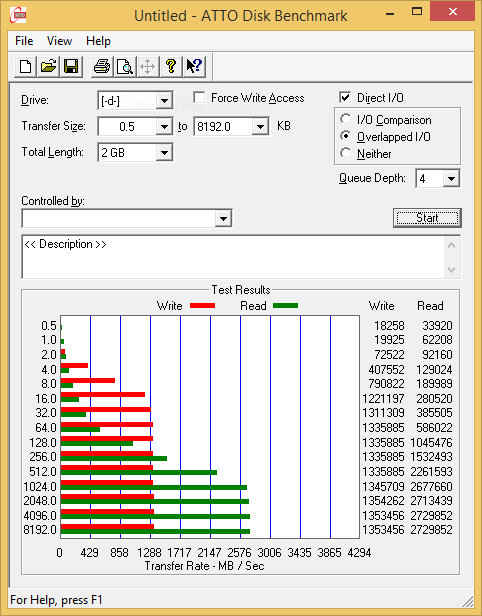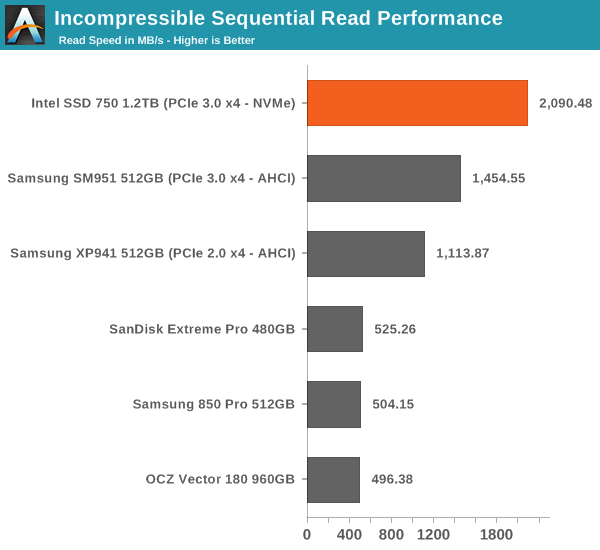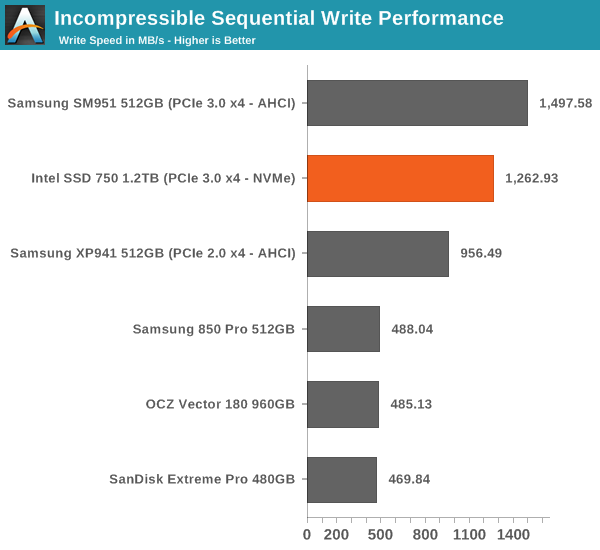Intel SSD 750 PCIe SSD Review: NVMe for the Client
by Kristian Vättö on April 2, 2015 12:00 PM ESTATTO - Transfer Size vs Performance
I'm keeping our ATTO test around because it's a tool that can easily be run by anyone and it provides a quick look into performance scaling across multiple transfer sizes. I'm providing the results in a slightly different format because the line graphs didn't work well with multiple drives and creating the graphs was rather painful since the results had to be manually inserted cell be cell as ATTO doesn't provide a 'save as CSV' functionality.
 |
|||||||||
AS-SSD Incompressible Sequential Performance
I'm also keeping AS-SSD around as it's freeware like ATTO and can be used by our readers to confirm that their drives operate properly. AS-SSD uses incompressible data for all of its transfers, so it's also a valuable tool when testing SandForce based drives that perform worse with incompressible data.


TRIM Validation
The move from Windows 7 to 8.1 introduced some problems with the methodology we have previously used to test TRIM functionality, so I had to come up with a new way to test. I tested a couple of different methods, but ultimately I decided to go with the easiest one that can actually be used by anyone. The software is simply called trimcheck and it was made by a developer that goes by the name CyberShadow in GitHub.
Trimcheck tests TRIM by creating a small, unique file and then deleting it. Next the program will check whether the data is still accessible by reading the raw LBA locations. If the data that is returned by the drive is all zeros, it has received the TRIM command and TRIM is functional.
And as expected TRIM appears to be working.











132 Comments
View All Comments
knweiss - Thursday, April 2, 2015 - link
According to Semiaccurate the 400 GB drive has "only" 512 MB DRAM.(Unfortunately, ARK hasn't been updated yet so I can't verify.)
eddieobscurant - Thursday, April 2, 2015 - link
You're right it's probably 512mb for the 400gb model and 1gb for the 1.2tb modelAzunia - Thursday, April 2, 2015 - link
In PCPer's review of this drive, they actually talk about the problems of benchmarking this drive. (https://www.youtube.com/watch?v=ubxgTBqgXV8)Seems like some benchmarks like Iometer cannot actually feed the drive, due to being programmed with a single thread. Have you had similar experiences during benchmarking, or is their logic faulty?
Kristian Vättö - Friday, April 3, 2015 - link
I didn't notice anything that would suggest a problem with Iometer's capability of saturating the drive. In fact, Intel provided us Iometer benchmarking guidelines for the review, although they didn't really differ from what I've been doing for a while now.Azunia - Friday, April 3, 2015 - link
Reread their article and it seems like the only problem is the Iometer's Fileserver IOPS Test, which peaks at around 200.000 IOPS, since you don't use that one thats probably the reason why you saw no problem.Gigaplex - Thursday, April 2, 2015 - link
"so if you were to put two SSD 750s in RAID 0 the only option would be to use software RAID. That in turn will render the volume unbootable"It's incredibly easy to use software RAID in Linux on the boot drives. Not all software RAID implementations are as limiting as Windows.
PubFiction - Friday, April 3, 2015 - link
"For better readability, I now provide bar graphs with the first one being an average IOPS of the last 400 seconds and the second graph displaying the standard deviation during the same period"lol why not just portray standard deviation as error bars like they are supposed to be shown. Kudos for being one of the few sites to recognize this but what a convoluted senseless way of showing them.
Chloiber - Friday, April 3, 2015 - link
I think the practical tests of many other reviews show that the normal consumer has absolutely no benefit (except being able to copy files faster) from such an SSD. We have reached the peak a long time ago. SSDs are not the limiting factor anymore.Still, it's great to see that we finally again major improvements. It was always sad that all SSDs got limited by the interface. This was the case with SATA 2, it's the case with SATA 3.
akdj - Friday, April 3, 2015 - link
Thanks for sharing KristianQuery about the thorough put using these on external Thunderbolt docks and PCIe 'decks' (several new third party drive and GPU enclosires experimenting with the latter ...and adding powerful desktop cards {GPU} etc) ... Would there still be the 'bottle neck' (not that SLI nor Crossfire with the exception of the MacPro and how the two AMDs work together--would be a concern in OS X but Windows motherboards...) if you were to utilize the TBolt headers to the PCIe lane-->CPU? These seem like a better idea than external video cards for what I'm Doing on the rMBPs. The GPUs are quick enough, especially in tandem with the IrisPro and its ability to 'calculate' ;) -- but a 2.4GB twin card RAID external box with a 'one cord' plug hot or cold would be SWEEET,
wyewye - Friday, April 3, 2015 - link
Kristian: test with QD128, moron, its NVM.Anandtech becomes more and more idiotic: poor articles and crappy hosting, you have to real pages multiple times to access anything.
Go look at TSSDreview for a competent review.